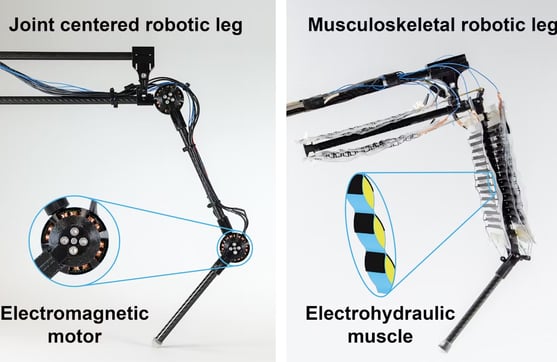A Giant Leap: The First Robot Leg with Artificial Muscles
Researchers have developed the first robotic leg with artificial muscles, mimicking human motion. Using electrohydraulic actuators, this innovation promises significant advancements in prosthetics, robotics, and AI-driven adaptive technologies.


In a groundbreaking innovation, researchers have developed the first robot leg equipped with "artificial muscles," a technology that mimics human motion far more naturally than traditional robotic limbs. This advancement, made by a Swiss-led team, employs electrohydraulic actuators, which resemble the muscles in the human body, making robotic movement more fluid and adaptable to different terrains. The leg can jump, move with agility, and offers improved energy efficiency compared to conventional motor-driven designs.
Why This Is Important
For prosthetics students, this innovation marks a significant leap toward creating better, more life-like artificial limbs. Traditional prosthetics often use rigid joints and motors, limiting their range of motion and flexibility. The use of artificial muscles changes that by allowing prosthetic limbs to mimic the way human muscles contract and expand, enabling smoother, more natural movement. This could improve the quality of life for people with limb loss, giving them prosthetics that can move more like a biological limb.
For AI students, the implications are equally exciting. The artificial muscles rely on precise control algorithms to interpret terrain and adjust movement. This type of sensory feedback and real-time processing opens the door to more sophisticated robots that can interact seamlessly with the world. AI is central to this technology, as it processes multiple signals to coordinate the robotic limb's response to different environments.
Technology Behind the Breakthrough
The core of the innovation lies in electrohydraulic actuators. These actuators are oil-filled bags equipped with electrodes that expand and contract like biological muscles. When voltage is applied, the liquid inside these bags shifts, causing the "muscle" to contract. This technology is not only effective but also energy-efficient. When the robot leg bends, like in a squatting position, it uses far less electricity than traditional motorized systems. This system can handle complex terrains, adjust its motion on the fly, and even jump up to 40% of its height.
The leg's artificial muscles are not just an improvement in motion—they are also cost-effective. The materials used in the actuators are inexpensive, raising the possibility that, with further development, this technology could be mass-produced. Current research shows promise, but the artificial muscle-powered leg is still tethered to a system, unable to move freely yet.
Impact on the Future
Globally, this innovation has the potential to revolutionize multiple industries. For robotics, the development of artificial muscles will lead to the creation of more versatile, human-like robots. These robots could be used in homes, factories, or medical facilities to assist with tasks that require both strength and precision, such as carrying heavy loads or handling delicate objects.
In the field of prosthetics, the potential to replicate natural movement would allow patients to experience greater mobility and comfort. As the technology advances, robotic legs with artificial muscles could replace the current generation of prosthetics, which rely on more rigid, less efficient mechanisms. This could be life-changing for individuals who need more responsive and adaptable limbs.
AI will also play a crucial role in the evolution of these systems. As robots become more agile and human-like in their movement, they will need advanced AI algorithms to make real-time decisions. Whether navigating rough terrain or adapting to new environments, the combination of AI and artificial muscles will allow robots to perform tasks previously impossible for machines.
Educational Benefits for Students
For students studying robotics, AI, or prosthetics, this innovation offers a new frontier of research and application. Engineering students can explore the design and material science behind the artificial muscles, while AI students will be involved in the complex programming required to control these muscles effectively.
For those in prosthetics, this research will redefine how they approach limb design. Instead of working with rigid joints and motors, students will have the opportunity to learn about soft actuators and their potential to replicate the complex dynamics of human motion. This opens doors for new learning opportunities in biomechanics, robotics, and even healthcare innovation.
Conclusion
The development of the first robot leg with artificial muscles is a groundbreaking step toward more human-like robots and more advanced prosthetic technology. With its ability to jump, walk, and adapt to different surfaces, this robotic leg showcases how artificial muscles could lead to more efficient, flexible, and versatile machines. For students in robotics, AI, and prosthetics, this technology offers a glimpse into the future—one where robots and prosthetic limbs are not only stronger but also more responsive and adaptive.
The information for the article about the first robot leg with artificial muscles was sourced from a detailed report on the breakthrough technology involving electrohydraulic actuators. These artificial muscles are soft actuators that mimic human muscle movement, enhancing robotic agility and flexibility. The research has significant implications for prosthetics and AI students, paving the way for more human-like and efficient prosthetics and robots. This study highlights advancements in energy efficiency, cost-effectiveness, and future potential for mass production.
For more details, you can refer to sources like BreezyScroll’s article on the development of the first robot leg with artificial muscles(BreezyScroll).
